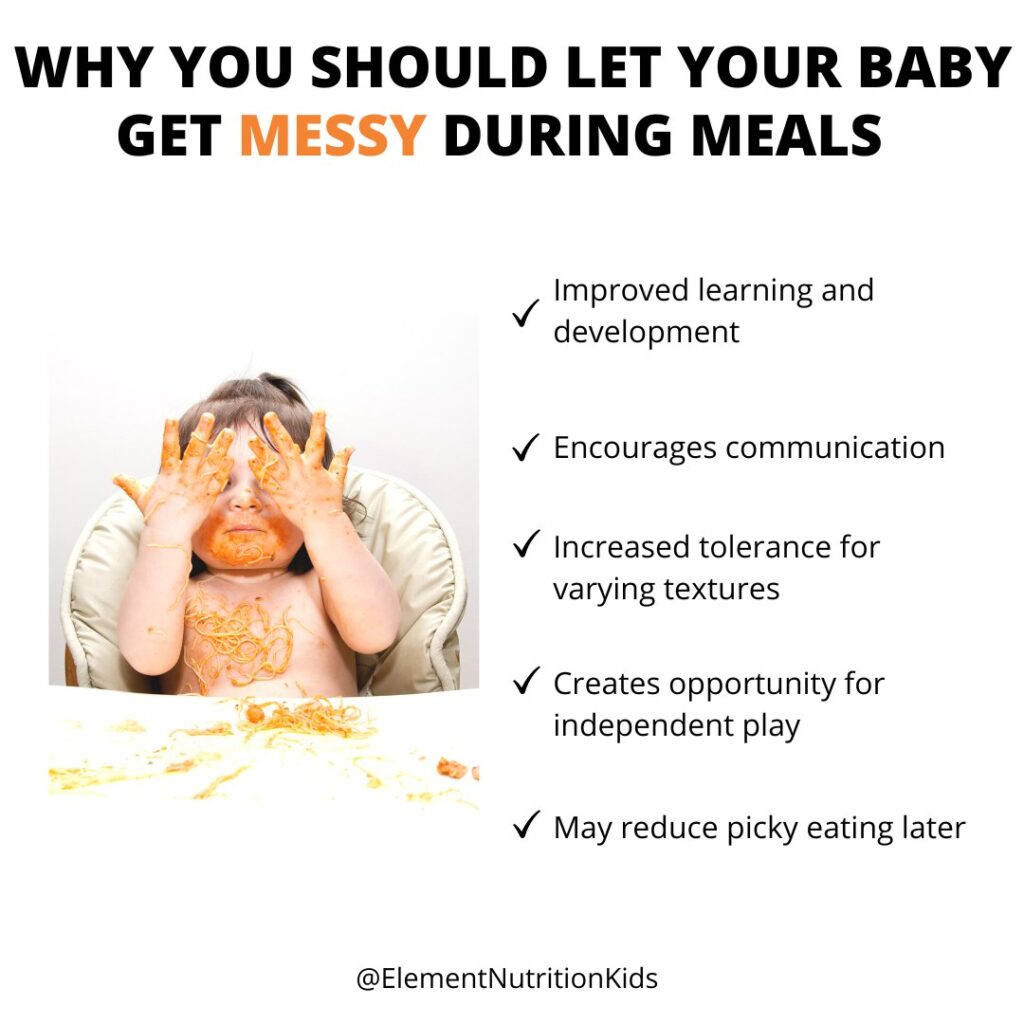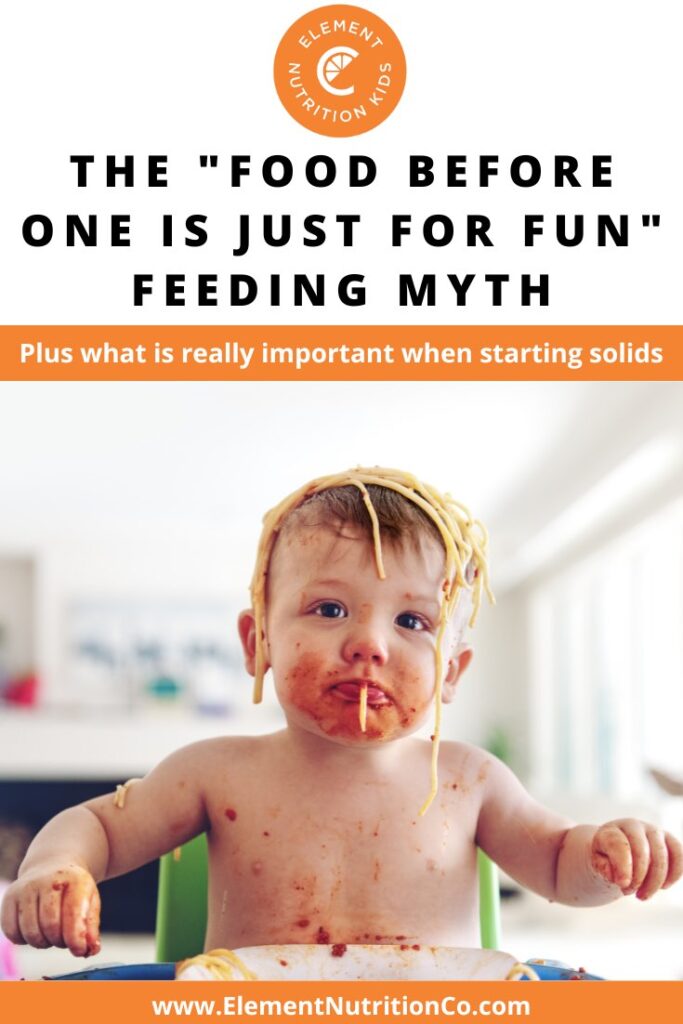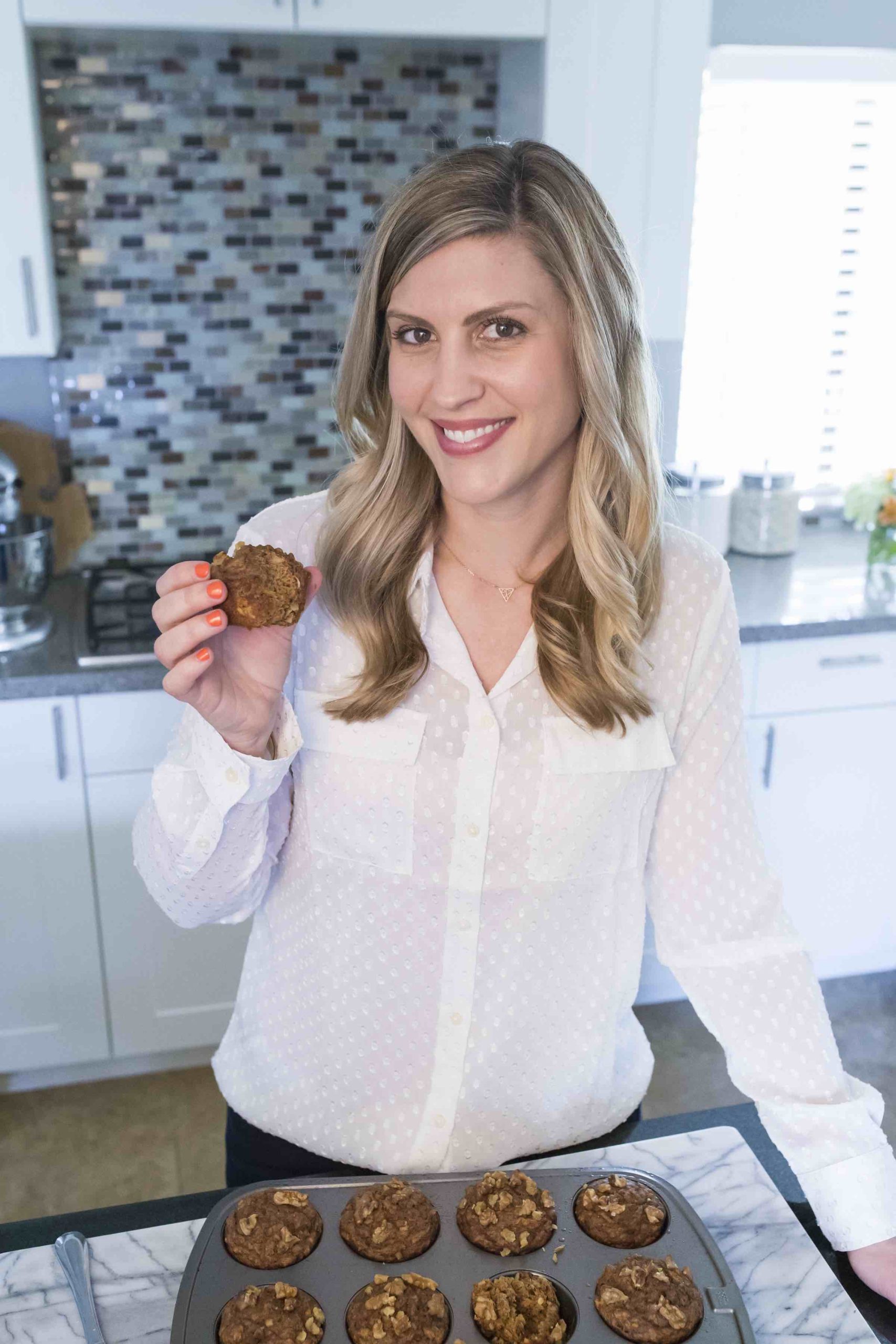Inside this article: The saying “food before one is just for fun” is one of the most commonly thrown around terms in the feeding baby world. However, this term is not only false, but it can also be dangerous if taken too seriously.
In this article, I’ll walk you through the reasons why food before one is for more than just fun. You will also learn the critical nutrients your baby needs from complimentary foods to thrive through their first year.

Please note that I am an affiliate for some of the linked products. If you click my affiliate link and make a purchase, I may earn a percentage of the sale at no extra cost to you. As an Amazon Associate, I earn from qualifying purchases.
Table of Contents
The food before one is just for fun myth
Breastmilk or formula makes up the majority of nutrition in your baby’s first year of life. Because of this, many falsely believe that the food their baby eats during the starting solids time frame doesn’t matter much.
Starting solids can also be a very anxiety-provoking time for many parents, so I also believe the food before one is just for fun term calms the nerves of many parents.
However, while the starting solids period should be fun, we know from research on babies’ growth and development that the actual food does matter, a lot. There are also several other key reasons the starting solids period is so important.
Key areas of importance when starting solids
Instead of leaning on the food before one is just for fun term, I like to encourage parents to take a more holistic approach to the starting solids process.
There are many factors at play in a baby’s development during this time frame, which I’ll outline here and then go into more detail in this article. All of these are equally important in your baby’s development.
- Nutrition (critical nutrients)
- Early introduction of allergens
- Enjoyment of food (fun) & exposure to flavors
- Social development
- Sensory development
Baby led weaning vs purees
Before we go deeper into the key areas of development when starting solids, I want to touch on a question that comes up a lot in my practice. What method of starting solids is best, baby-led weaning or puree?
And the quick answer is either method. Ensuring your baby is getting the right nutrients they need from complimentary foods is important. The feeding environment is also important. However, the method you use to introduce solids isn’t.
Babies can successfully start solids using a baby-led weaning or traditional weaning approach. A combination method also works great for many parents.
What I feel is more important is that parents choose the method that makes them most comfortable. A relaxed parent during the process creates a better feeding environment for the baby.
Food before one is for: Nutrition
Around 6 months of age, when babies are developmentally showing signs of readiness for solids, they also have a HUGE jump in their nutrient needs (macro and micronutrients like vitamins/minerals). Some of these nutrients are in such high demand in their body that breastmilk and formula alone can’t meet the need after 6 months.
Complimentary foods (starting solids) are intended to fill in the gaps between what your baby needs and what breastmilk and formula can’t provide during this time of rapid growth.
As your baby gradually becomes a more skilled eater, the volume of food they eat increases and naturally the volume of breast milk or formula decreases.
This slow transition between 4-6 months and 1 year allows your baby to get the nutrition they need from breastmilk/formula and food if the foods they are served are properly planned.
Nutritional needs of infants
There are 6 key nutrients I like to emphasize when talking to parents about starting solids. These nutrients are required in higher levels and are an important focus area when starting solids.
#1 Iron
Iron carries oxygen to cells for storage and is very important during times of rapid growth (such as during the first year of life.)
Iron also plays a critical role in brain development. Lack of iron during infancy and early toddlerhood, when the brain is rapidly developing has been shown to increase the risk for long-term neuro-cognitive issues.
Between 6-12 months your baby needs 11 mg of iron each day.
During your pregnancy, your baby stock piles iron (transferred from mom), and these iron levels typically sustain a baby through the first 4 to 6 months of life. A key volume of iron transfer happens between mom and baby toward the end of the pregnancy and through delayed cord clamping after birth.
Around 6 months, your baby’s iron stores start to deplete and they depend on iron from outside sources (breastmilk, formula, and complementary foods). While the iron in breastmilk is highly bioavailable, it is not enough alone to sustain a baby’s iron needs much past the 6-month window.
Additionally, babies born prematurely or those born from mothers with iron deficiency often don’t even have enough iron stores to make it to the 4-6 month window. These babies may require supplementation. Always talk with your pediatrician if you think your baby may be iron deficient.
Because of all of the above, iron-rich foods are an important first food source for your baby. You can introduce iron-rich foods right away when starting solids, including meats when served appropriately.
Iron rich baby foods
- Heme Iron (animal-based)
- Chicken
- Beef
- Animal liver
- Pork
- Turkey
- Fish
- Shrimp
- Crab
- Non-Heme (plant-based)
- Breastmilk/formula
- Oatmeal/baby cereal
- Peas
- Beans
- Lentils
- Creamy nut butter
- Egg yolk
- Soybeans
- Tofu
- Spinach
- Green beans
- Sweet potato
Iron rich baby food puree
The most nutrient-dense iron-rich baby food puree you can make is beef liver. I know it doesn’t sound super appealing, but babies surprisingly gobble it up. It is one of my top recommended foods when starting solids, particularly for babies who need extra iron.
1 oz. of beef liver contains 5.1 mg of iron.
Animal liver in general contains a ton of iron so serving it to your baby is a great way to boost their iron intake naturally. It is also one of the most bioavailable forms of iron so it’s absorbed well in comparison to plant-based iron sources.
Iron rich foods for baby led weaning
If you plan to follow the baby-led weaning method, you might wonder how to get enough iron-rich foods into your baby. While babies following the BLW method typically don’t get as much iron into their bodies when first starting as babies eating purees, over time things balance out. BLW can absolutely provide enough iron if don’t correctly.
Keep in mind, baby-led means your baby is self-feeding and leading the process. It doesn’t HAVE to mean no puree foods. They can self-feed purees too, so you can absolutely provide the iron-rich baby food puree I mentioned above.
If your goal is to only provide “solid” foods for self-feeding, then give your baby a lot of opportunities with extra soft dark meats that have a high fat content. These are more easily eaten by your baby (they’re not so dry.)
- Crockpot beef roast in low sodium bone broth creates a great texture.
- Dark meat chicken or turkey (near the bone is also higher in iron content and less dry than something like chicken breast.)
- Thin-cut flank steak was a favorite of both of my babies. They would suck that meat dry!
All of the foods listed above in the iron-rich baby foods section can be served either pureed or in soft whole form for baby-led weaning as well.
If you want to follow the baby-led weaning method but are feeling unsure of the details, you can grab a copy of “Baby’s first bites.” I walk you through both methods of feeding, how to safely introduce foods and a recommended schedule.
Tips to maximize iron intake in Babies
- Provide at least two servings of iron-rich foods per day
- Heme sources are best absorbed, so focus on those first if your family consumes meat
- Combine non-heme sources with Vitamin C-rich foods (orange, strawberry, tomato products, etc.) Vitamin C improves the absorption of iron.
- Combine iron-rich foods to maximize iron intake (mix cereals with breast milk/formula, egg yolk or nut butter, mix meat and peas/beans)
- Watch out for organic products that may not be iron-fortified
- Focus on natural iron-based foods sources over heavily fortified foods when possible (for example: meat and beans over depending on heavily fortified cereals as the sole iron source.)
#2 Zinc
Zinc supports growth and immune development as well as appetite. These are all important for rapidly growing babies. There is also limited storage ability for zinc in the body so regular intake is important.
Between 7-12 months your baby needs 3 mg of zinc each day.
Your baby will get zinc from both breastmilk and formula but they also need an increased volume of zinc as they transition to the 7 month mark of life.
Some food sources of zinc are similar to the food sources for iron (particularly meats and beans), so typically if their iron needs are being met, their zinc needs are being met as well.
Zinc rich foods for baby
- Beef
- Beans
- Dark meat chicken
- Whole milk (only as a beverage after 1 yr.)
- Yogurt
- Zinc fortified cereals
Tips to maximize zinc intake in babies
- Offer foods rich in zinc daily
- Provide meat separately when possible instead of as a mixed dish when first starting solids. This will ensure more zinc-containing foods are eaten
- Watch out for organic products that may not be zinc-fortified
#3 Vitamin D
Vitamin D helps the body absorb calcium for bone strength. This is especially important in babies because their bones are growing rapidly. Low vitamin D has also been indicated in obesity and several chronic diseases.
Between 6-12 months your baby needs 400 IU of vitamin D.
Breastmilk is low in vitamin D, therefore, it is recommended that all breastfed babies take a vitamin D supplement starting at birth.
Formula-fed babies should also take a vitamin D supplement until they are able to consistently drink 32 oz of formula each day.
These are the vitamin D drops I always recommend to my clients, I also used these for both of my babies from day 1 through year one (and even beyond). 1 drop provides 400 IU of vitamin D and there are enough drops in 1 bottle to last a full year. Super easy!
Vitamin D sources for baby
The best source of vitamin D for your baby in the first year is going to be a vitamin D supplement. However, there a few other places your baby can get some vitamin D.
- Vitamin D supplement drops
- Salmon
- Canned light tuna in oil
- Full-fat yogurt
- Fortified cereal (oats/o’s)
- Sunlight (though this is tough since we slather our kids in sunscreen 🙂)
#4 Fat
Fat is an important source of energy for babies, especially for their brain which is going through rapid development and growth in the first 1000 days of life. Fat is also important for helping the body absorb the fat-soluble vitamins A, D, E & K.
Babies between 6-12 months need about 30 g of fat each day.
Before 2 years, babies should not consume any low-fat or fat-free food products. They need ALL the fat they can get from their diet. Breastmilk is high in fat and thus is a great fat source for babies. About 50% of the energy a baby gets from breast milk is from fat.
High fat food for baby
- Breastmilk or formula
- Full-fat yogurt
- Cheese
- Butter
- Avocado
- Nut/seed butter,
- Oil (olive, avocado, etc.)
- Fatty fish
- Egg yolks
- Hummus
Tips to maximize fat intake in babies
- Provide a variety of fat sources every day
- Avoid low-fat products
- Cook with oil
- Mix nut/seed butter into oatmeal or spread thinly on toast strips or squares
#5 DHA
DHA is important in the development of the brain (cognitive development) and retina of the eye during the first 24 months. Many children are not getting enough DHA because the sources of food that contain DHA are not commonly consumed.
Babies between 6-12 months need 10-12 mg/kg of body weight
Breastfed babies can get enough DHA from breastmilk as long as the mother is adequately supplementing with DHA.
This is the DHA supplement I took during pregnancy and postpartum. I liked the strawberry flavor which prevented gross flavor in the mouth, huge for that first-trimester nausea.
Many infant formulas are also fortified with DHA.
DHA food for baby
If your baby isn’t consuming much in the way of DHA-rich foods, you could consider offering them a liquid DHA baby supplement particularly once they start drinking less breastmilk or formula and into year 2 of their life.
Here are some foods to focus on for DHA:
- Breastmilk/formula
- Salmon
- Trout
- Mackerel
- Sardines
- Herring
- Fortified eggs
- Canned light tuna
Tips to maximize DHA intake in babies
- Breastmilk/formula typically provides enough DHA as long as it’s fortified
- Provide 1-2 servings of low mercury sources of fish each week
- If getting your baby/toddler to eat fish is hard, consider a supplement
#6 Choline
Choline is important for your baby’s brain development and growth. Newer research is also indicating that choline may be as important as folate during pregnancy.
Research has suggested that supplementing the mom or baby’s diet with choline over the first 1000 days of life could support brain development, protect against neural and metabolic issues and improve cognitive function. (1)
Adequate intake for babies 6-12 months is 150 ml choline/day.
I believe choline will continue to get more attention as additional research comes out, especially since it is identified that many children are not getting enough choline in their diets.
Food sources of choline for baby
- Breastmilk (mom supplementing with choline)
- Fortified formulas
- Eggs
- Beef
- Beef liver
- Salmon
- Peanut butter
Tips to maximize choline intake in babies
- Serve baby eggs (1 egg has 147 mg of choline, almost their daily need)
- If breastfeeding, mom should maintain their own choline intake by eating choline-rich foods (above) and supplementing with choline (500 mg/day).
- For families following a plant-based or vegan diet, choline deficiency may be a risk once breastfeeding/formula stops. A child may need a choline supplement.
Food before one is for: Early introduction of allergens
We can’t talk about staring solids without talking about introducing allergens. This is probably the scariest part of the entire starting solids process for most parents, myself included, even with my robust education on the topic. There are so many unknowns.
Research has shown that introducing the top baby food allergens early (around the 4-6 month mark) and definitely before 1 year, may reduce the occurrence of childhood food allergies. (2)
Early introduction is especially important for babies who are at higher risk for food allergies. Be sure to discuss the timeline for introducing them with your pediatrician if you have a strong family history of food allergy if your baby has had significant eczema or has had a reaction to immunizations.
You can read about this topic in more detail in my baby food allergens article, where I walk through each allergen and how to introduce them.
Food before one is for: Exposure to new flavors
Babies have this magical window between 4-6 months and really up through the first year when they are very open to trying new foods and flavors. This is often called the “flavor window.” (3)
In fact, the early introduction of flavors (especially bitter flavors like veggies) has such an impact on a child’s acceptance of foods that many providers recommend something called flavor training.
Flavor training is introducing flavors early and repetitively to prime the palate to like those flavors. It may also reduce picky eating in toddlerhood and beyond.
One of my goals when introducing my kids to solids was to provide as many new foods and flavors as possible before they turned one. I even created this “foods to try before one checklist” to help me keep track. So many of my clients and readers have found it incredibly helpful and I’d love for you to have a copy too!
Food before one is for: Social development
Eating food in good company is one of the many joys in life. Starting solids is a key opportunity to include your kids in family meals.
One of the most powerful ways kids learn is through observation. Watching you eat teaches them so much about how to feed themselves.
Through this process, they learn social skills, utensil skills, table manners, and how to try new things. If you want your kids to like a variety of food, let them watch you eat and enjoy a variety of food.
The earlier you can get your baby/kids eating with you the better. Just one meal per day is more than enough to get started. It could be breakfast, lunch, or dinner, don’t put too much pressure on it to make it perfect, just enjoy the process.

Food before one is for: Sensory development
Starting solids is the perfect opportunity to get ALL your baby’s senses active. They learn to see the food, smell the aroma of the food, hear the sounds of cooking, touch the various textures of food, taste the flavors, and feel the change in their belly as they move from hungry to full.
Sensory development in all areas is such an important part of your baby’s learning to enjoy food and the eating experience.
One of the biggest things many parents struggle with is the mess involved in starting solids. I get it, it is messy and it takes time to clean up. But letting your kids get messy during the process is SO important for their development.
Babies who are allowed to get messy during eating tend to be more adventurous with food. They have fewer sensory issues (ie: they don’t freak out when things get on their hands as toddlers.)
Benefits of messy food play for babies
- Fosters curiosity
- Develops interest in new foods
- Familiarizes them with new textures
- May reduce picky eating
- Improves sensory comfort
- Fun!
Constantly wiping your baby’s face and hands can actually create bigger issues down the road including a more extreme version of picky eating. So, let them get messy!

Summary
The term “food before one is just for fun” is a huge feeding myth that really needs to disappear. Not only is it misleading to many parents, it can also be dangerous if taken too seriously.
Starting solids should be a fun and enjoyable process for both babies and parents but it is also a critical time for nutrients through complementary foods. Through this process babies also learn many important developmental and social skills such as family meals, utensil skills, acceptance of flavor and texture variety, and more.
Learning to have fun while supporting a baby’s budding skills is key during this time frame.
If you’re feeling unsure during the starting solids process, be sure to reach out to a pediatric dietitian such as me who can guide you step by step through the process.
You can also download my full step-by-step guide “Baby’s first bites” to support your journey.
If you found this article helpful, I’d love it if you could share it with another parent who might find it helpful as well. And, if you share on social media, be sure to tag me @elementnutritionkids.
For more helpful feeding tips and to be notified of new articles I publish you can also sign up to receive my monthly newsletter: “The Good Bite” which comes once a month, straight to your inbox.

